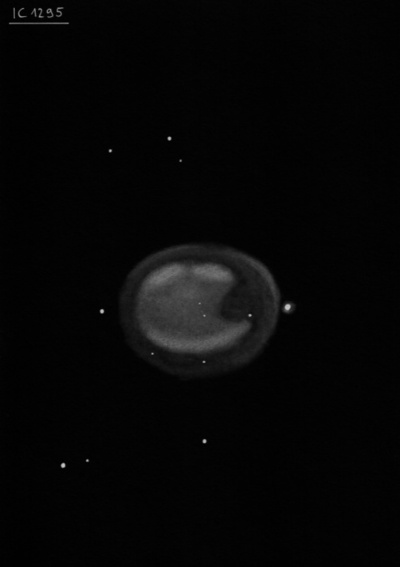
Truman Safford discovered IC 1295 = Sf 82 on 28 Aug 1867 with the 18.5-inch Clark refractor at Dearborn Observatory in Chicago and recorded "pB, pL, gbM." Heber Curtis first recognized it as a planetary nebula in 1919. Burnham's Celestial Handbook and the Sky Atlas 2000.0 mislabel this planetary as IC 1298.
In 1919, Heber Curtis reported it was undoubtedly a planetary nebula based on a Crossley photograph and described it as "Exceedingly faint; a faint, hazy ring about 2' x 1.5' in p. a. 90°±. The central portions are relatively vacant, and it is fainter along and at the ends of the major axis. There are three faint stars at the center, of which one is probably the central star."
100/150mm - 5" visible with a 5" stop on my 13.1" without filter and easy with UHC at 79x!
200/250mm - 8" (6/27/81): faint, round, fairly small. Located 25' ESE of NGC 6712 in the same low power field. Observation mentioned in 10/81 S&T for smallest scope!
300/350mm - 13.1" (7/27/84): the rim on the south or SW side appears brighter but no definite annularity was seen.
13.1" (8/15/82): fairly faint, appears slightly elongated in an E-W orientation.
400/500mm - 17.5" (6/30/00): fairly bright at 220x using a UHC filter as a roundish disc, ~1.6'x1.4'. The surface brightness is irregular and it appears slightly brighter along the southwest and northwest portion of the rim. The unfiltered view at 280x also reveals a mottled appearance with a mag 13.5-14 star situated right at the west edge and a mag 14.5 star in the interior (a bit offset from center). A couple of extremely faint stars are at the following edge. Located 24' ESE of NGC 6712.
17.5" (5/10/86): bright, large, round, 1.5' diameter. Very pretty at 220x, estimate V = 12.0-12.5. The stellar planetary K 4-8 is just 4.6' WNW.
600/800mm - 33" (9/16/07): at 200x appeared weakly annular with a slightly darker hole in the center and slightly brighter rim except on the west edge where there was an indentation or darker notch taking a small bite out of the rim.
Notes by Steve Gottlieb